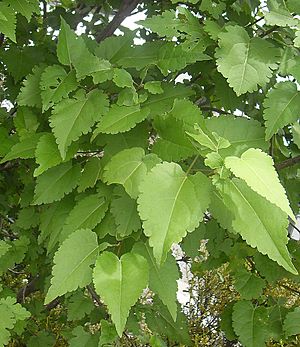Hoheria glabrata facts for kids
Quick facts for kids Mountain lacebark |
|
|---|---|
 |
|
| Scientific classification | |
| Genus: |
Hoheria
|
| Species: |
glabrata
|
The mountain lacebark (also called ribbonwood) is a special kind of plant. Its scientific name is Hoheria glabrata. It belongs to the Malvaceae family, which also includes plants like cotton and hibiscus. This tree is found only in New Zealand. This means it is endemic to New Zealand.
It is one of the few trees in New Zealand that loses its leaves every year. We call these trees deciduous. The mountain lacebark can grow up to 10 m (33 ft) tall. Its leaves are green for most of the year. In autumn, they turn a bright yellow color. Beautiful white flowers bloom on the tree around January.
About the Mountain Lacebark
Where It Grows
The mountain lacebark mostly grows in the wet, mountainous areas of New Zealand's South Island. It loves places with lots of rain. You can find it in forests and along riverbanks.
What It Looks Like
The leaves of the mountain lacebark have small teeth along their edges. They also have a special heart shape. This heart shape helps you tell it apart from a very similar tree called Hoheria lyallii. The mountain lacebark is usually a small tree. It often grows many branches right from its base.
How People Used It
Long ago, the Māori people of the South Island used the bark from Hoheria glabrata and Hoheria lyallii. They called Hoheria lyallii by the name houi. They likely used the bark to make textiles. Textiles are materials like cloth or fabric. This shows how useful these trees were to early New Zealanders.

